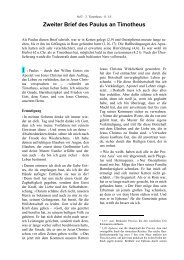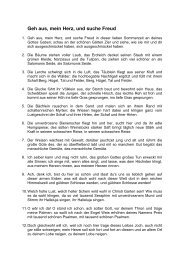Create successful ePaper yourself
Turn your PDF publications into a flip-book with our unique Google optimized e-Paper software.
less viscous liquid, called the perilymph, and they<br />
are connected at the apex of the cochlea (by the<br />
helicotrema). The scala vestibuli begins at the<br />
oval window, and the scala tympani ends at the<br />
membrane of the round window.<br />
The cochlear duct and the scala vestibuli are separated<br />
by an elastic sheet, called the vestibular<br />
membrane. This membrane reproduces the waveshaped<br />
changes in volume caused by the incident<br />
sound. The endolymph then transmits the vibrations<br />
to the basilar membrane which lies between<br />
the cochlear duct and the scala tympani. Eventually<br />
the round window is reached via the perilymph.<br />
Because of this shortcut the vibrations do<br />
not have to travel all the way round through the<br />
helicotrema. The vestibular and basilar membranes<br />
thus vibrate in unison.<br />
The spiral-shaped bulge of the organ of Corti is<br />
located above the basilar membrane. It consists<br />
of sensory cells, twelve thousand of which,<br />
arranged in rows of three to five, make up the<br />
exterior hair cells. The interior 3,500 hair cells<br />
as well as the structural support cells lie in one<br />
row. The 12,000 sensory cells are arranged on<br />
a 32 mm long lamina in four parallel rows having<br />
a total width of only 1/20 mm. Their geometrical<br />
sequence and distribution resemble that of piano<br />
keys in a linear scale. At one end the cells are<br />
tuned to a maximum frequency of between<br />
10 and 20 kHz, which descends to about 30 Hz at<br />
the other end.<br />
When sounds are received, the basilar membrane<br />
vibrates in sympathy, but the amplitude is inconceivably<br />
minute, only about 10 -11 m. This is equal<br />
to 100 picometres or one thousand millionth of<br />
a cm (one million million pm = 1 metre) which<br />
approaches the size of a few atoms. The tips of<br />
the outer hair cells penetrate a covering membrane<br />
(the tectorial membrane) which projects<br />
into the cochlear duct. Volume changes in this<br />
passage cause the basilar membrane to move relative<br />
to the tectorial membrane so that the sensory<br />
hairs experience a slight shearing pressure.<br />
These stimuli are then transmitted as electrical<br />
signals along the cochlear (auditory) nerve to the<br />
brain. It should be noted that these signals not<br />
28<br />
only travel to the brain, but also in the reverse<br />
direction. For this purpose there are two types of<br />
neural tissue at the base of the hair cells, namely<br />
the afferent (leading to the brain) and the efferent<br />
fibres leading to the hair cells. The reason for<br />
this feedback is not yet understood and this is<br />
only one of the many unsolved puzzles.<br />
There are about 15,000 receptor cells (hair cells)<br />
in the cochlea and they are sensitive to different<br />
sound frequencies (Diagram, page 27). The hair<br />
cells are located in ordered rows on the basilar<br />
membrane, which is a thin wall extending<br />
through the entire cochlea, following all its convolutions.<br />
An incident sound image is separated<br />
into its single component frequencies, each of<br />
which stimulates only a small fraction of the<br />
15,000 sensory cells located at a specific position<br />
on the basilar membrane. The functioning of the<br />
cochlea is highly complex, and its ingenious<br />
structure is not yet fully understood.<br />
Special abilities of the ear: The ear is the most<br />
sensitive human sensory organ. Sounds with frequencies<br />
between about 20 Hz and 16 kHz are<br />
audible. Lower frequencies are felt rather than<br />
heard. All natural sounds are highly complex;<br />
pure tones consisting of a single sinusoidal frequency<br />
are not found in nature. But when they<br />
are produced artificially, they are of great experimental<br />
use. Sounds and noises can be considered<br />
as a mixture of sinusoidal tones having different<br />
frequencies and amplitudes. A tone can be<br />
regarded as being the elementary unit for natural<br />
sounds and noises. A 3 kHz note having an energy<br />
level of only 4 x 10 -17 W/cm 2 can be heard, and in<br />
general audible sound intensities lie in the range<br />
between 10 -16 and 10 -4 W/cm 2 (Diagram, page 23).<br />
Speech detection: Amongst all living things the<br />
gift of speech is unique. Only man has been<br />
endowed by the Creator with this exceptional<br />
means of communication. It essentially requires<br />
four independent organ systems:<br />
– The larynx which produces the sounds<br />
(phonation).<br />
– The mouth and throat which modulate the<br />
sounds produced by the larynx to form recog-
















